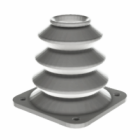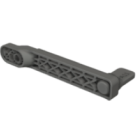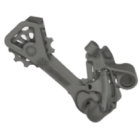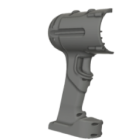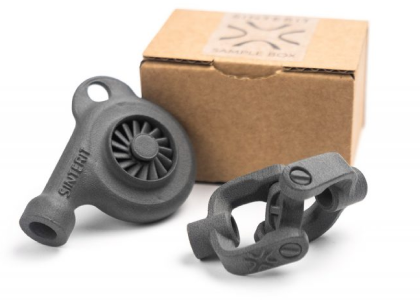DLP 3D printing
Digital Light Processing (DLP) is a resin-based 3D printing technology known for its high precision and fast build speeds. It’s widely used in applications where accuracy, fine detail, and smooth surfaces are critical — such as dental models, jewelry, micro-mechanical parts, and visual prototypes.
This chapter breaks down exactly what DLP 3D printing is, how it works, what materials it uses, and when it makes the most sense to choose it over other technologies.
What is DLP 3D printing?
DLP stands for Digital Light Processing, a technology originally developed for digital projection. In the context of 3D printing, it refers to a photopolymer-based process where liquid resin is selectively cured layer by layer using a projected image of ultraviolet (UV) light.
So when people ask, “What is DLP 3D printing?” or “What is the meaning of DLP 3D printer?” — the answer is simple: it’s a high-resolution, light-based printing method that uses digital projection to solidify resin in precise shapes.
How does DLP 3D printing work?
The DLP 3D printing process is fast, efficient, and precise:
- A thin layer of photopolymer resin is spread across the build platform.
- A digital projector flashes a UV light image of the entire layer at once.
- The resin cures (solidifies) wherever it was exposed to light.
- The build platform lifts, and the next layer is exposed.
- The process repeats until the object is fully built.
Unlike SLA (stereolithography), which uses a laser to trace the shape point by point, DLP cures an entire layer simultaneously — which significantly improves build speed without sacrificing detail.
DLP 3D printing materials explained
DLP printers rely on light-sensitive resins, also known as photopolymers, which are selectively cured using ultraviolet light. These materials are prized for their exceptionally smooth surface finish, fine detail resolution, and their ability to deliver properties tailored to specific applications — including flexibility, mechanical strength, castability, and biocompatibility. Depending on the use case, DLP printers can work with a variety of resin formulations. Standard resins are typically used for visual prototypes and aesthetic models, while castable resins are designed for precise burnout in jewelry and dental casting processes. Toughened resins offer greater durability for functional prototypes, and biocompatible resins are essential in producing surgical guides, dental trays, crowns, and similar clinical devices. The range and performance of DLP materials continue to evolve rapidly, especially in sectors like dentistry and fine jewelry, where DLP 3D printing machines are setting new standards for accuracy and surface quality.
Key advantages of DLP 3D printing technology
DLP’s core strengths make it ideal for specific, high-precision use cases.
Advantages:
- speed: since each layer is cured all at once, print times are shorter than SLA,
- resolution: DLP can achieve fine features and sharp edges, even on small parts,
- surface finish: smooth surfaces with minimal post-processing,
- accuracy: excellent dimensional precision and reproducibility,
- detail: DLP excels in printing small fonts, intricate textures, and microstructures.
Limitations of DLP 3D printing
Despite its strengths, DLP 3D printing technology has some trade-offs.
Disadvantages:
- printer price: industrial DLP machines are significantly more expensive than consumer FDM printers. DLP 3D printer price varies greatly depending on resolution and projection system,
- build volume: typically smaller than FDM or SLS machines,
- material brittleness: most standard resins are more fragile than thermoplastics,
- post-processing: requires thorough cleaning (e.g. in IPA) and UV curing after printing,
- resin handling: photopolymers can be skin and eye irritants, and require careful disposal,
DLP vs FDM 3D printing: key differences
| Feature | DLP | FDM |
|---|---|---|
| Resolution | Very high | Moderate |
| Surface finish | Smooth, fine | Layer lines visible |
| Materials | Light-cured resins | Thermoplastic filaments |
| Strength | Brittle (unless reinforced) | More ductile |
| Print speed | Fast for small parts | Slower overall |
| Use case | Precision models, dental, jewelry | Mechanical parts, prototypes |
FDM vs DLP 3D printing is less about competition and more about choosing the right tool. FDM is more forgiving and functional; DLP is for precision, aesthetics, and complexity on a small scale.
Overview of DLP 3D printing machines
DLP 3D printing machines range from entry-level desktop units to industrial-grade production systems. What sets them apart is primarily the projector resolution (measured in microns per pixel), build size, resin compatibility, and system automation.
High-end systems may include:
- automated resin filling and leveling,
- heated resin vats for viscosity control,
- integrated post-curing stations,
- dental-specific workflows and FDA-certified resins
Desktop systems exist for prosumers and small labs, but in professional settings — such as digital dentistry — DLP is almost always the go-to resin technology due to its balance of speed, precision, and reproducibility.
DLP 3D printing summary: is it the right technology for you?
Digital Light Processing (DLP) is a resin-based 3D printing technology that uses UV light to cure liquid photopolymers with exceptional speed and precision. By projecting an entire layer at once, rather than tracing it point by point, DLP achieves significantly faster print times than laser-based SLA systems, without compromising surface quality or detail. This makes it particularly well-suited for applications in dentistry, jewelry, and miniature modeling, where accuracy and fine resolution are critical. While material options for DLP are expanding — including tough, castable, and biocompatible resins — parts still require thorough post-processing to reach final usability. Compared to FDM, DLP offers much finer resolution and smoother finishes, but with trade-offs in build volume and overall part toughness. For users seeking ultra-precise results in a compact, efficient format, DLP remains one of the most compelling technologies in the additive manufacturing landscape.
Explore also
- Overview of 3D printing tech
- What is SLS printing?
- What is FDM 3D printing?
- What is SLA 3D printing?
- MJF 3D printing
- What is DMLS and SLM 3D printing?
- Binder Jetting
- Material Jetting
- PolyJet printing
- New 3D printing technology
- 3D print vs injection molding
Related categories




